El órgano virtual
definitivo
El B-3 V captura toda la textura, suciedad y grandeza del órgano de rueda armónica clásico y el altavoz giratorio, y le añade modulación, efectos y opciones de diseño de sonido perfectas para la música actual.
Esencial en el rock, jazz, góspel, R&B, soul, reggae y house: este órgano icónico puede pasar de sutil a rugiente en un instante. Los músicos tenían que cargar con aquel monstruo de 180 kg a los conciertos. Cualquier estudio que fuera en serio tenía que tener uno. Con el B-3 V, tendrás toda la personalidad y estilo del instrumento auténtico, en una forma que encaja a la perfección en los procesos musicales creativos de hoy día.
El pasado y el futuro se dan la mano
Lo primero es lo primero: nuestro B-3 V se toma muy en serio la asombrosa historia de este órgano. Pero la potencia del software también consigue trucos imposibles de concebir en el original.
Absolutamente auténtico
Hemos modelado con precisión los componentes del órgano de rueda armónica y el modo en que interactúan usando la misma tecnología TAE® de nuestra galardonada V Collection, lo que se traduce en un instrumento que no solo suena, sino que se comporta igual que el auténtico.
De susurros a gritos
Crea tonos optimistas para baladas o tira de más barras de armónicos, sube el drive del previo a válvulas y desmelénate. El B-3 V cumple.
Vueltas y vueltas
El altavoz giratorio es parte esencial del sonido espacioso tan conocido y apreciado, y la emulación que incorpora el B-3 V lo reproduce con una precisión sin igual.
Para el escenario y el estudio
Graba pistas con la rueda armónica que encajan a la perfección en la mezcla de tu proyecto y aprovecha en el escenario la poca potencia de proceso que requiere el B-3 V. (Advertencia: los teclistas que haya entre el público querrán saber qué instrumento estás tocando)

El bólido
de los teclados
Es “ese sonido” que cualquier persona sabe reconocer. Ha sido muy apreciado por figuras del jazz como Jimmy Smith y Shirley Scott, roqueros como Keith Emerson, Yes, Deep Purple y Santana, y el gigante del soul Booker T. Jones.
Un básico del reggae. La línea de bajo de innumerables temas de house. Y nunca se pensó para nada de eso.
Los creadores del órgano de rueda armónica lo imaginaron como el centro de la sala de estar y como una solución para las iglesias que no podían permitirse un órgano tubular. Pero el mundo tenía planes más ambiciosos.
El órgano de rueda armónica fue ideado por el relojero Laurens Hammond y el inventor John Hanert, que juntos lanzaron la primera versión en 1935. El B-3, el modelo más reconocible y deseado, tuvo una presencia magnífica: no dejó de fabricarse de 1954 a 1974.
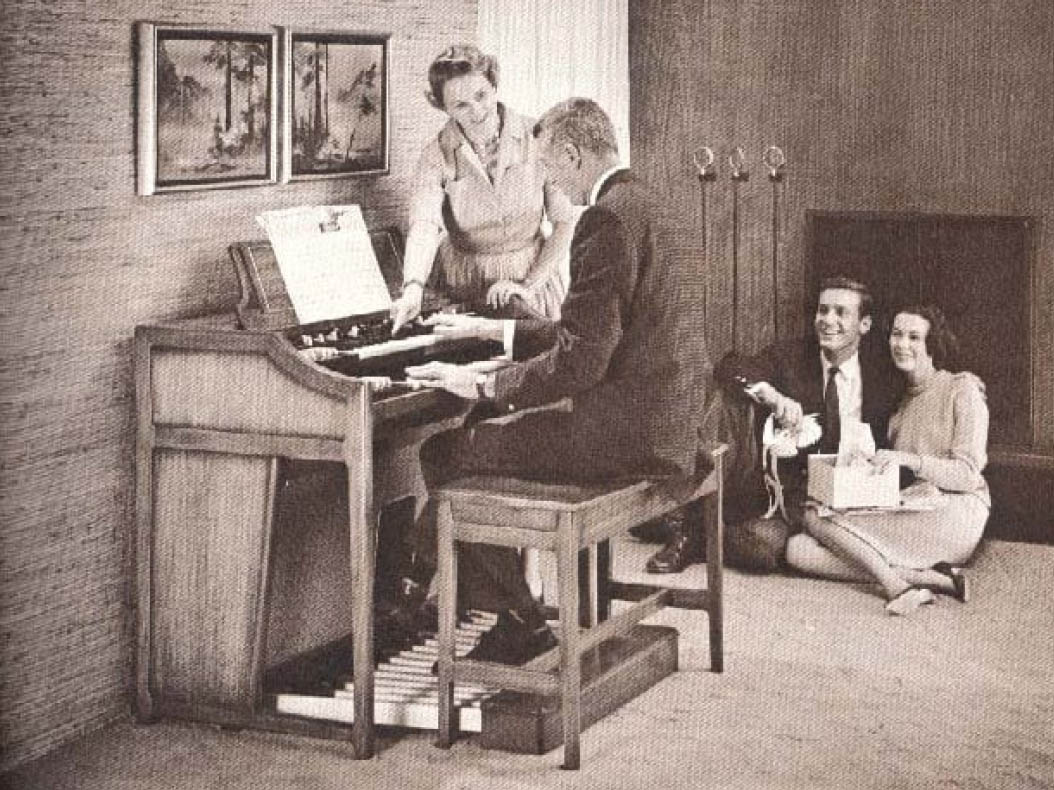
Perfección
mecánica
El B-3 V emula todos y cada uno de los pasos del complejo proceso mecánico de esta máquina para crear un instrumento virtual que no solo suena como el auténtico: también se comporta igual.
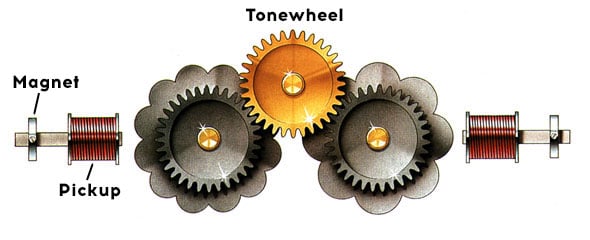
El homólogo del B-3 V era electromecánico y combinaba ruedas tonales giratorias con pastillas para producir tonos aflautados en octavas y armónicas para cada nota. Se podían mezclar de forma variable con una serie de 9 barras de armónicos para lograr un repertorio de timbres aditivos, desde suaves y ligeros hasta otros pronunciados y resonantes.
Pero el B3 se guardaba varias prestaciones especiales en la manga. La función de percusión, que añadía un sonido con decaimiento rápido en el segundo o tercer armónico, le daba a cada nota un ataque punzante, perfecto para solos e interpretación rítmica. La función exclusiva de modulación ofrecía tres profundidades distintas de vibrato o intensidades de chorus.
Realismo
máximo
Distribución y aspecto de los controles exactamente como en el original.
Al emular un instrumento tan mítico, hay ciertas cosas que simplemente no cambias. Por eso, las barras de armónicos, los conmutadores y demás controles están ubicados exactamente donde los organistas esperarían encontrarlos. Y además, tienen un aspecto convincente.

La barras de armónicos superiores, de pedal e inferiores están colocadas en el centro, de izquierda a derecha.
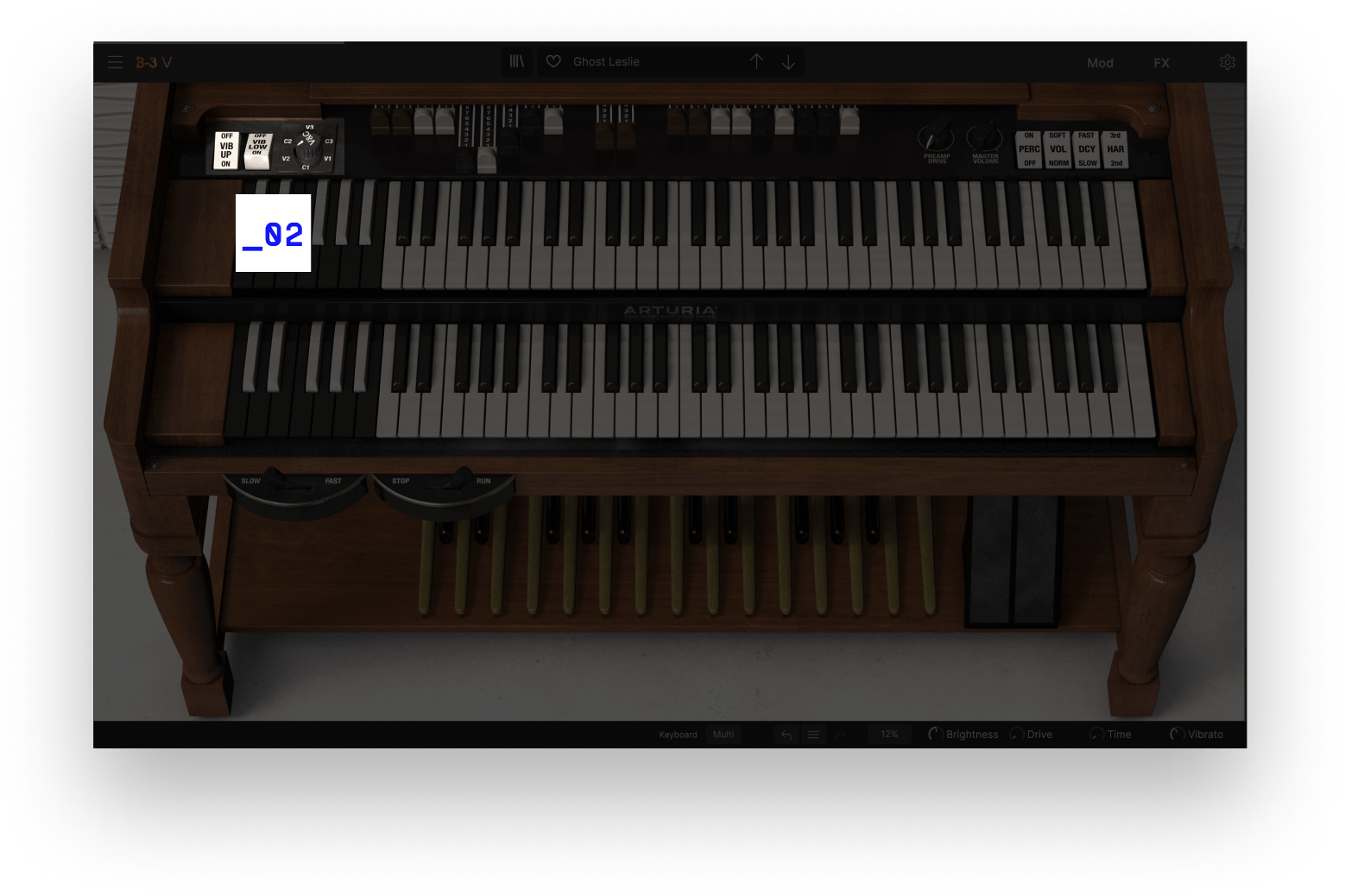
El vibrato mediante barrido mecánico se ha reproducido con un nivel exquisito de detalle y se puede asignar por separado a los manuales bajo/pedal. Los modos de chorus duplican el popularísimo efecto de refuerzo.
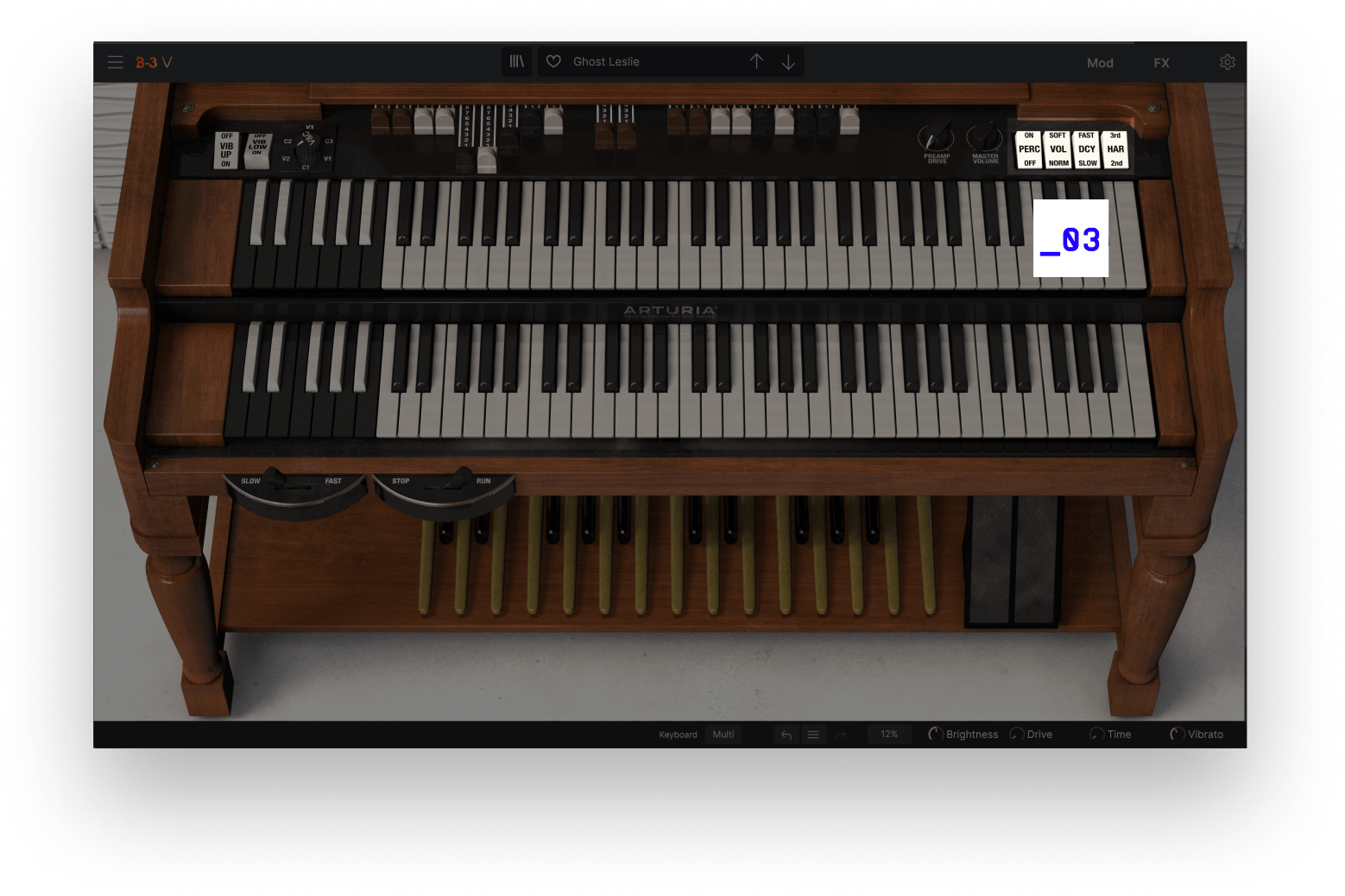
También hemos capturado el tintineo aislado tan propio de los solos de jazz y rock, con opciones de activación/desactivación, volumen, decaimiento y armónicos en la zona superior derecha.

Conmutadores realistas con diseño de “media luna” alternan las velocidades lenta (coral) y rápida (trémolo) del altavoz giratorio, o bien detienen por completo el giro, un efecto usado por el organista de fusión Brian Auger.
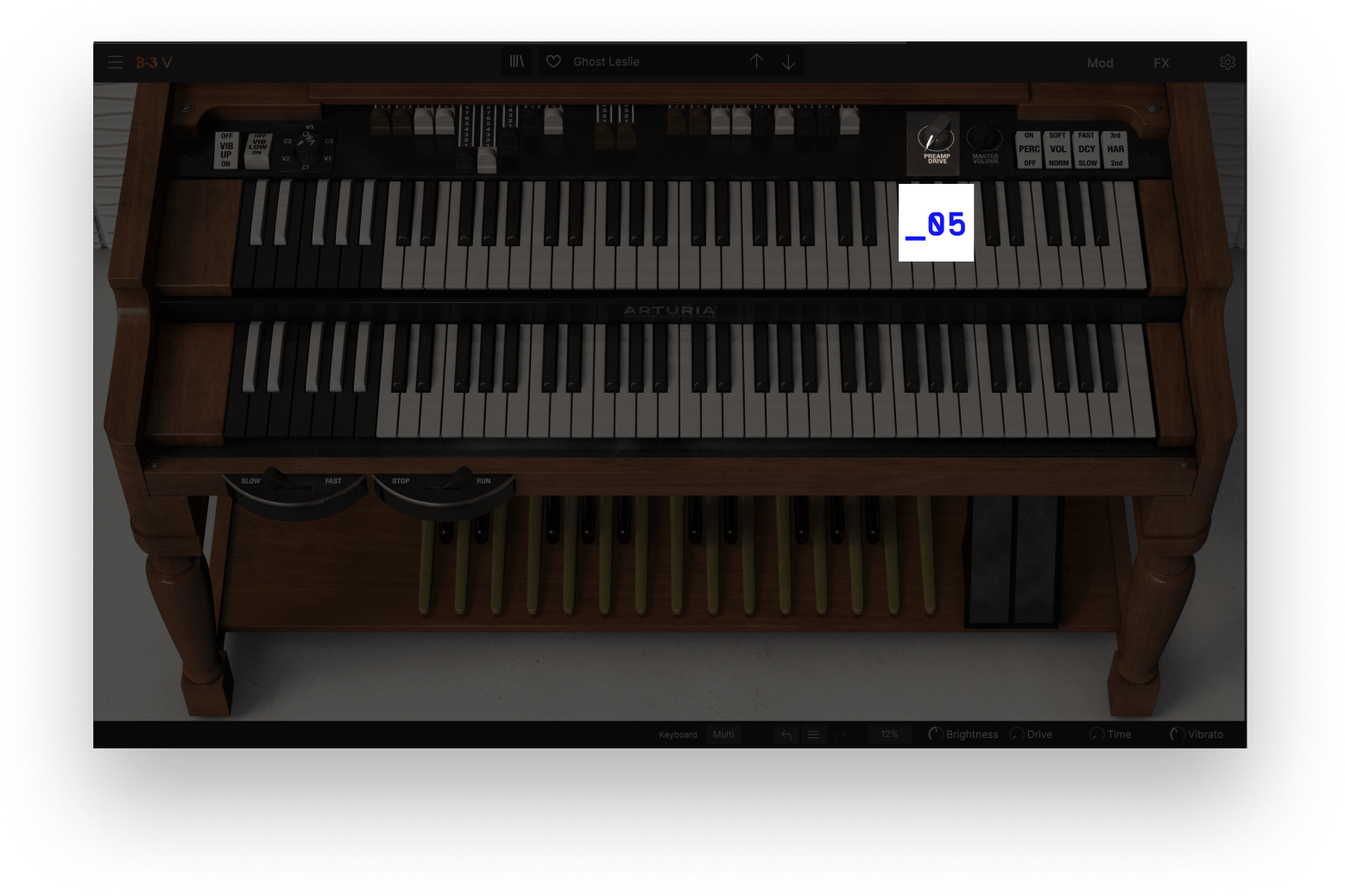
Sube la textura cálida del previo a válvulas AO28 original con esta exclusiva de Arturia.
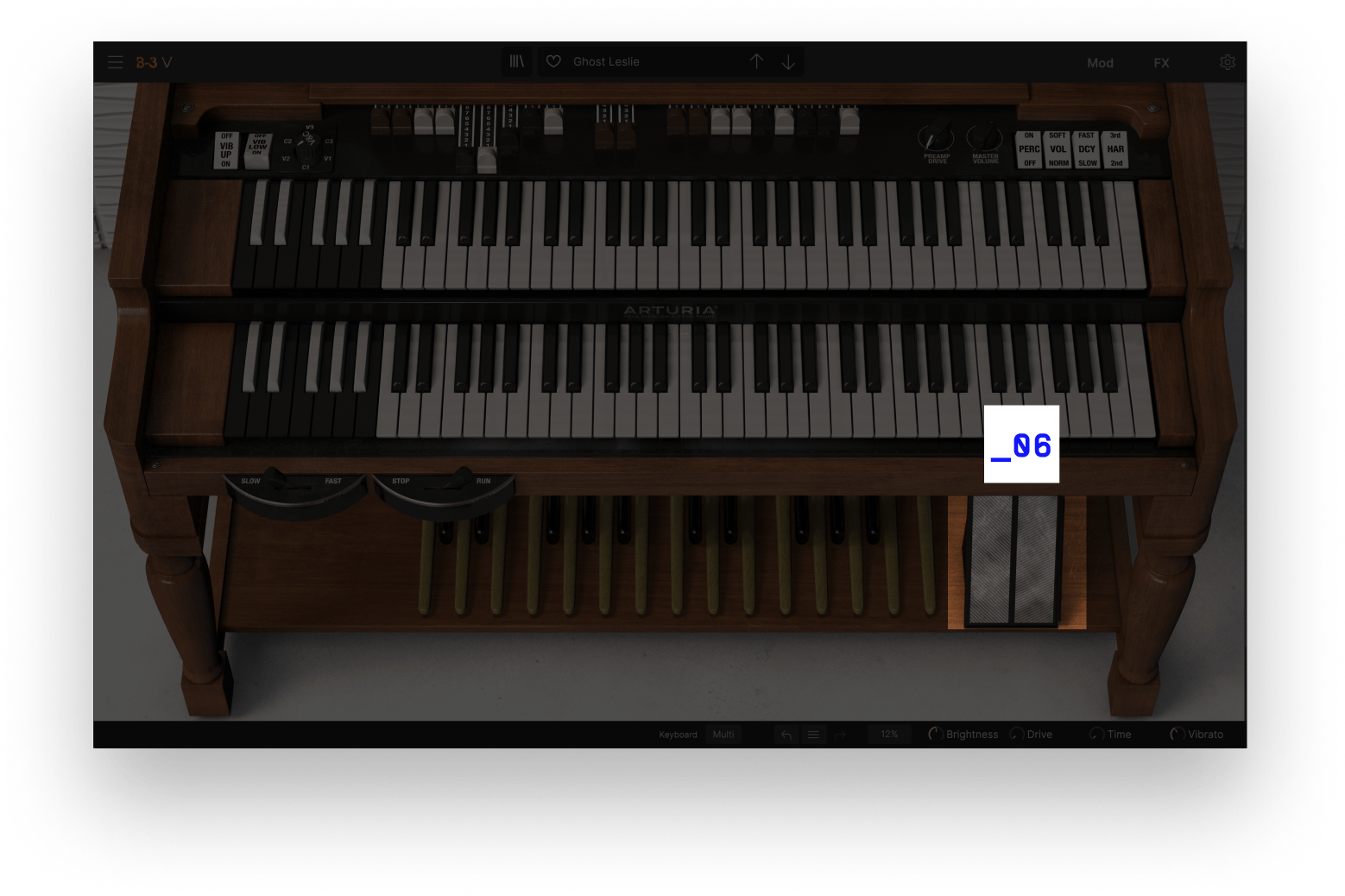
Igual que en el original, preserva más frecuencias con volúmenes más bajos, optimizando el sonido para el modo en que el oído humano percibe la sonoridad.
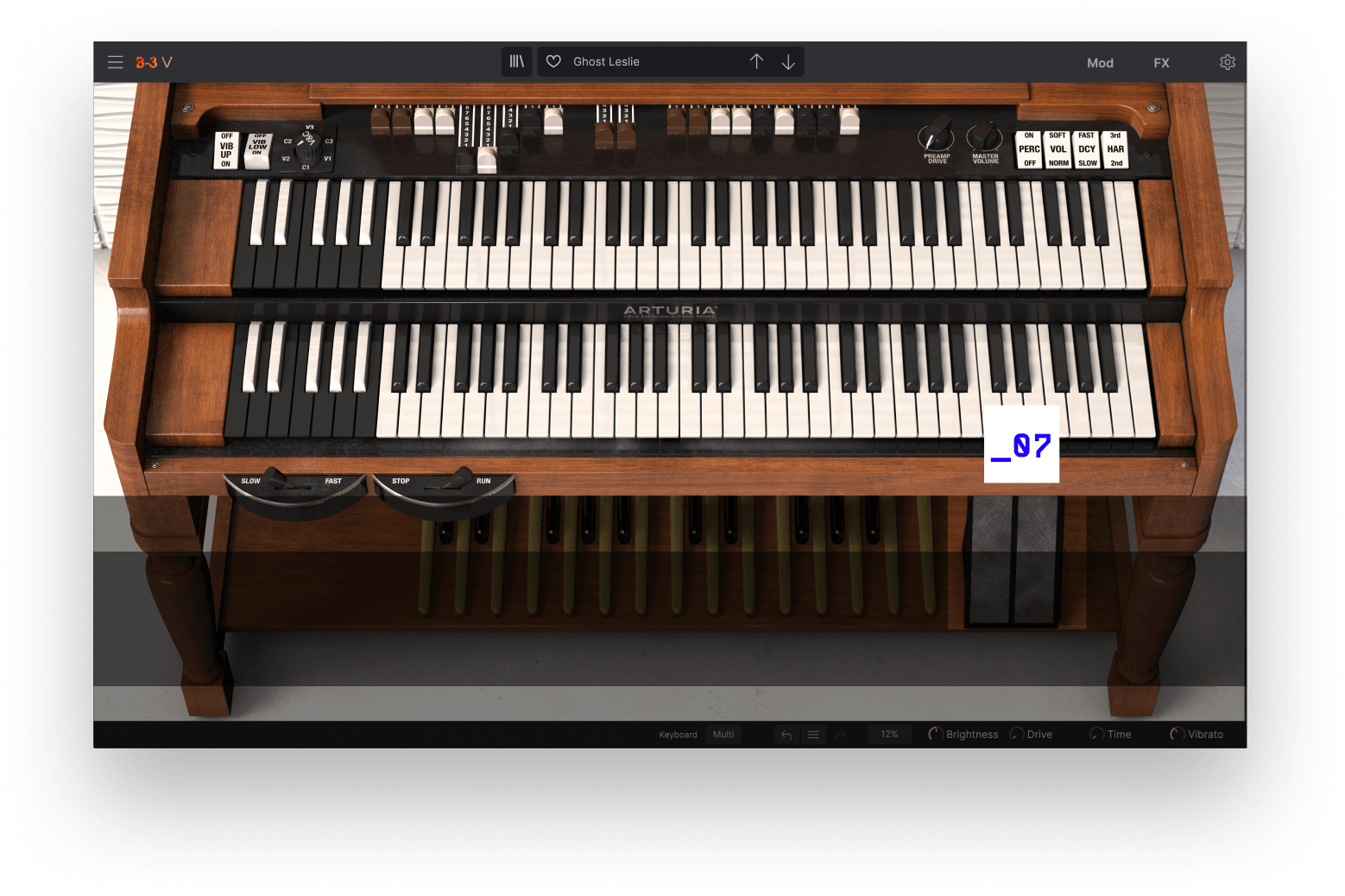
Crea el controlador de órgano definitivo manipulando los manuales superiores, inferiores y de pedal con canales MIDI independientes.
Modificaciones
modernas
La tecnología actual mejora el instrumento.
El panel Mod te da acceso a los entresijos del B-3 V de formas que habrían necesitado un soldador con el original —o habrían sido totalmente imposibles.
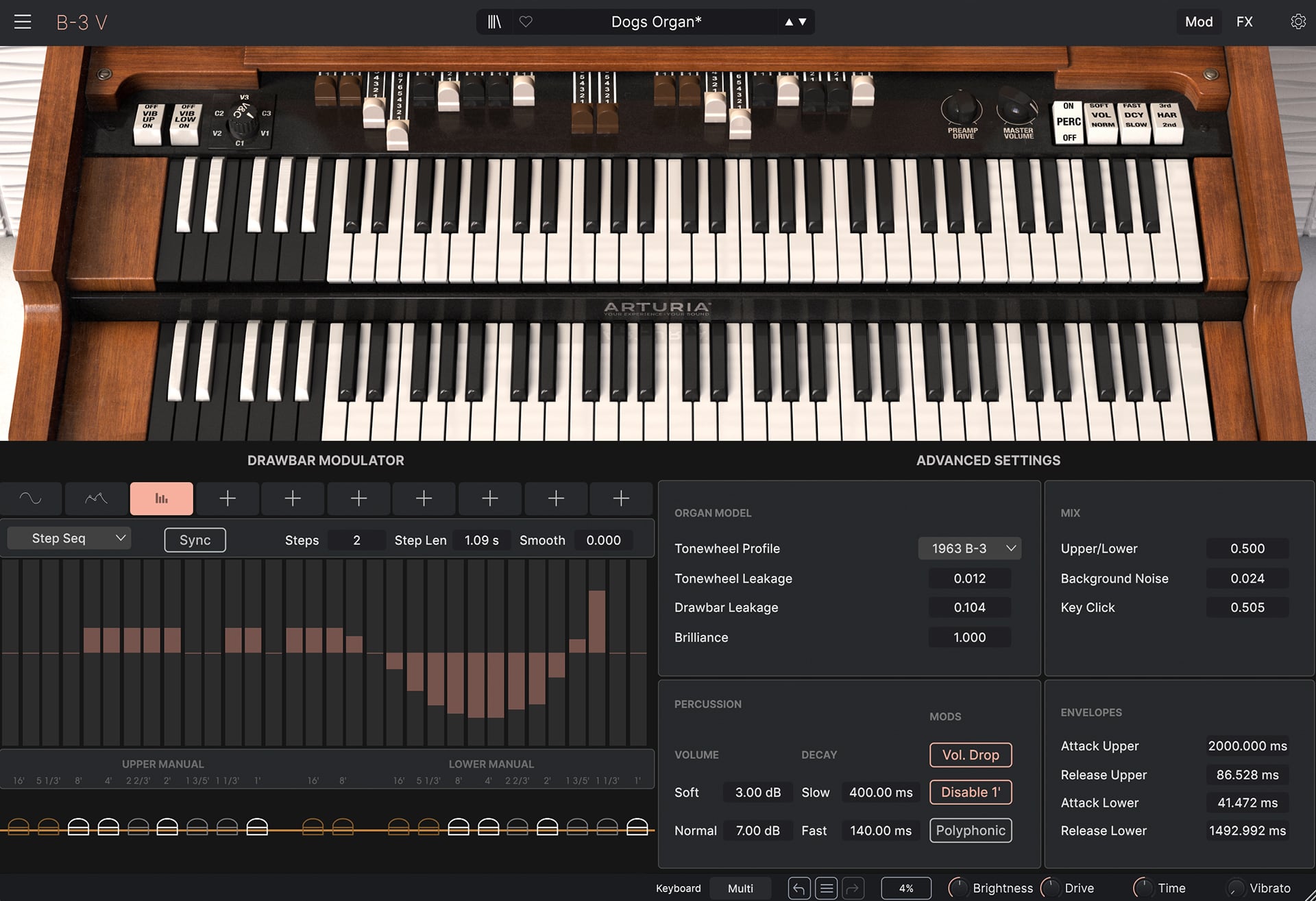
_1
_2
_3
_4
_5
01. Modelo de órgano
Regresa al pasado con varias ediciones y modelos, y controla con exactitud cuánta interferencia se produce (se da cuando las ruedas armónicas y barras de armónicos son captadas por otras adyacentes).
02. Percusión
Establece tiempos de decaimiento exactos para la percusión armónica, además de si baja el volumen del manual superior y/o "roba" la barra de tiro de 1' como hacía en el instrumento físico.
03. Mezcla
Equilibra los manuales superior e inferior y el importantísimo clic de tecla, un pequeño “pop” de estática que les encantaba a los músicos de jazz y rock.
04. Envolventes
Conserva la envolvente de encendido y apagado instantáneos del clásico o aumenta los tiempos de ataque y liberación para lograr un sonido más parecido al de un órgano de iglesia
05. Modulador de barra de armónicos
Con esta herramienta todoterreno es como si tuvieras diez manos extra con las que manipular las barras de armónicos al tocar, con movimiento de un LFO, envolvente de varios puntos o secuenciador por pasos.
Todo un estudio
lleno de efectos
Ajusta el altavoz giratorio, añade una pedalera y coloca el B-3 V en espacios acústicos virtuales.
La generosa sección de efectos del B-3 V te permite diseñar el sonido final de órgano que imagines, sin salir de una única instancia del plugin.
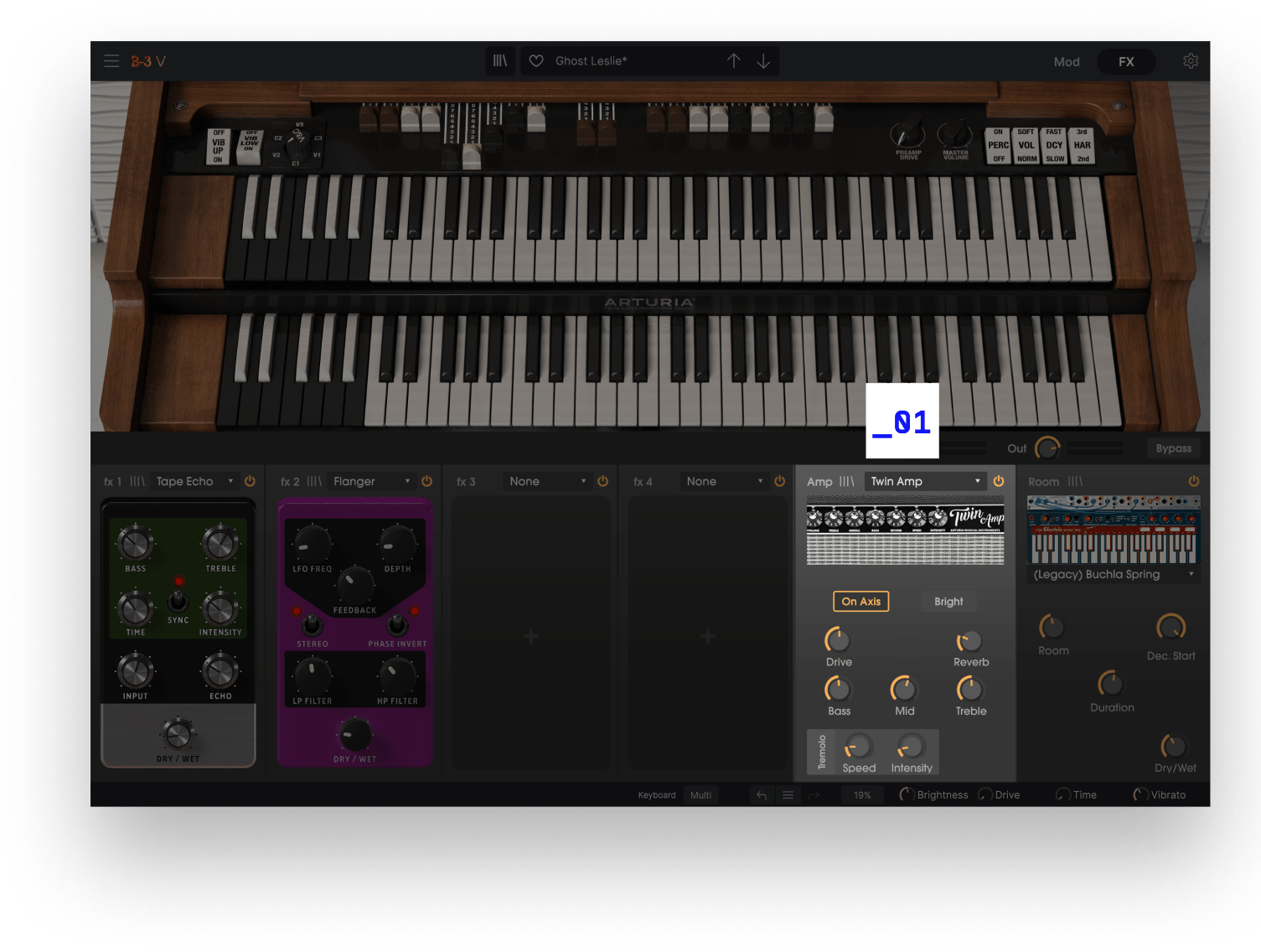
Switch between Rotary Speaker and Twin Amp modes for ultimate tonal flexibility. Shape your sound with drive, reverb, EQ, and tremolo controls, delivering authentic vintage warmth.
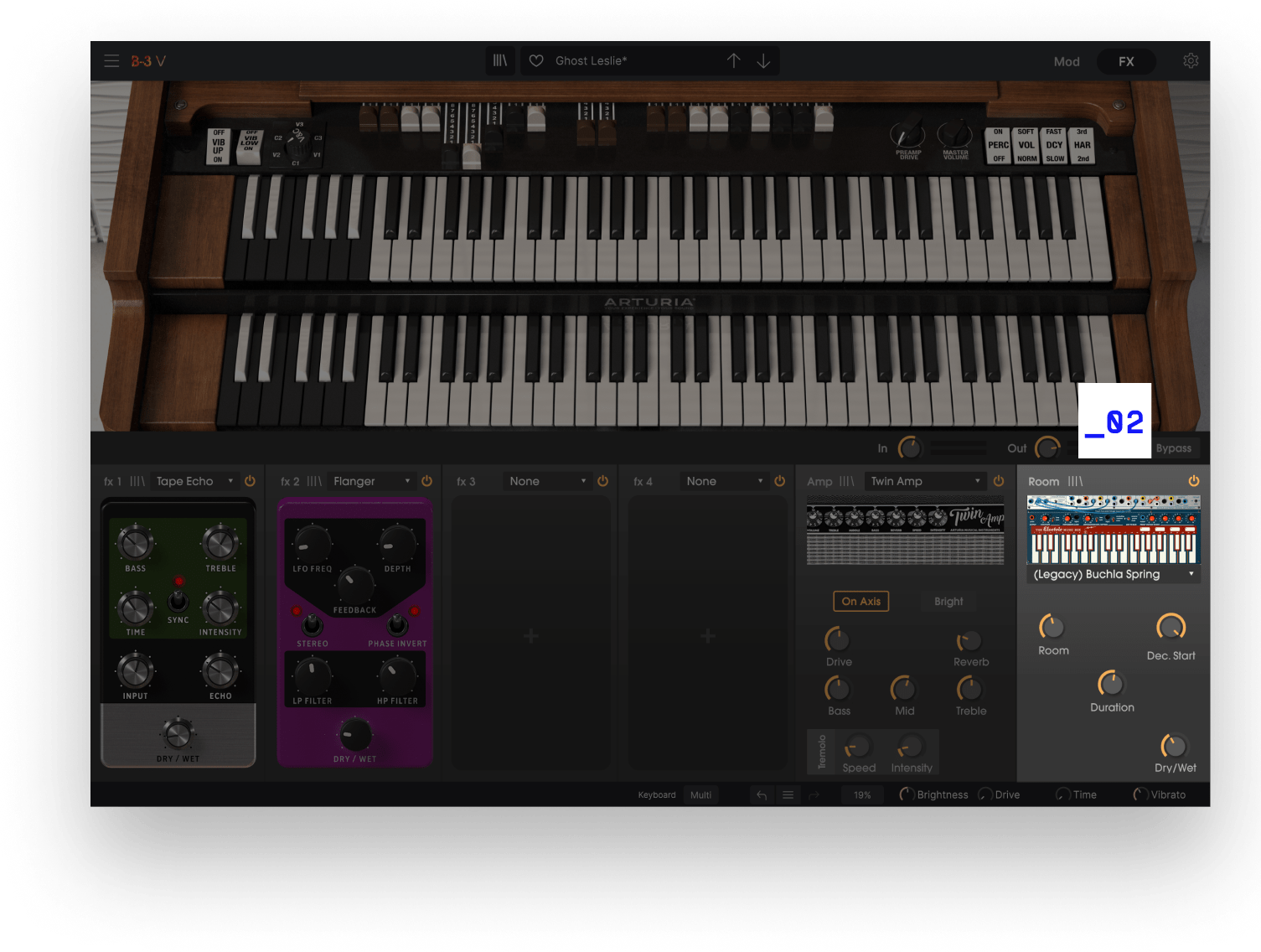
Escoge un espacio para lograr la atmósfera ideal. El B-3 V también simula reverbs de placas, de resortes y otras modernas de estudio.
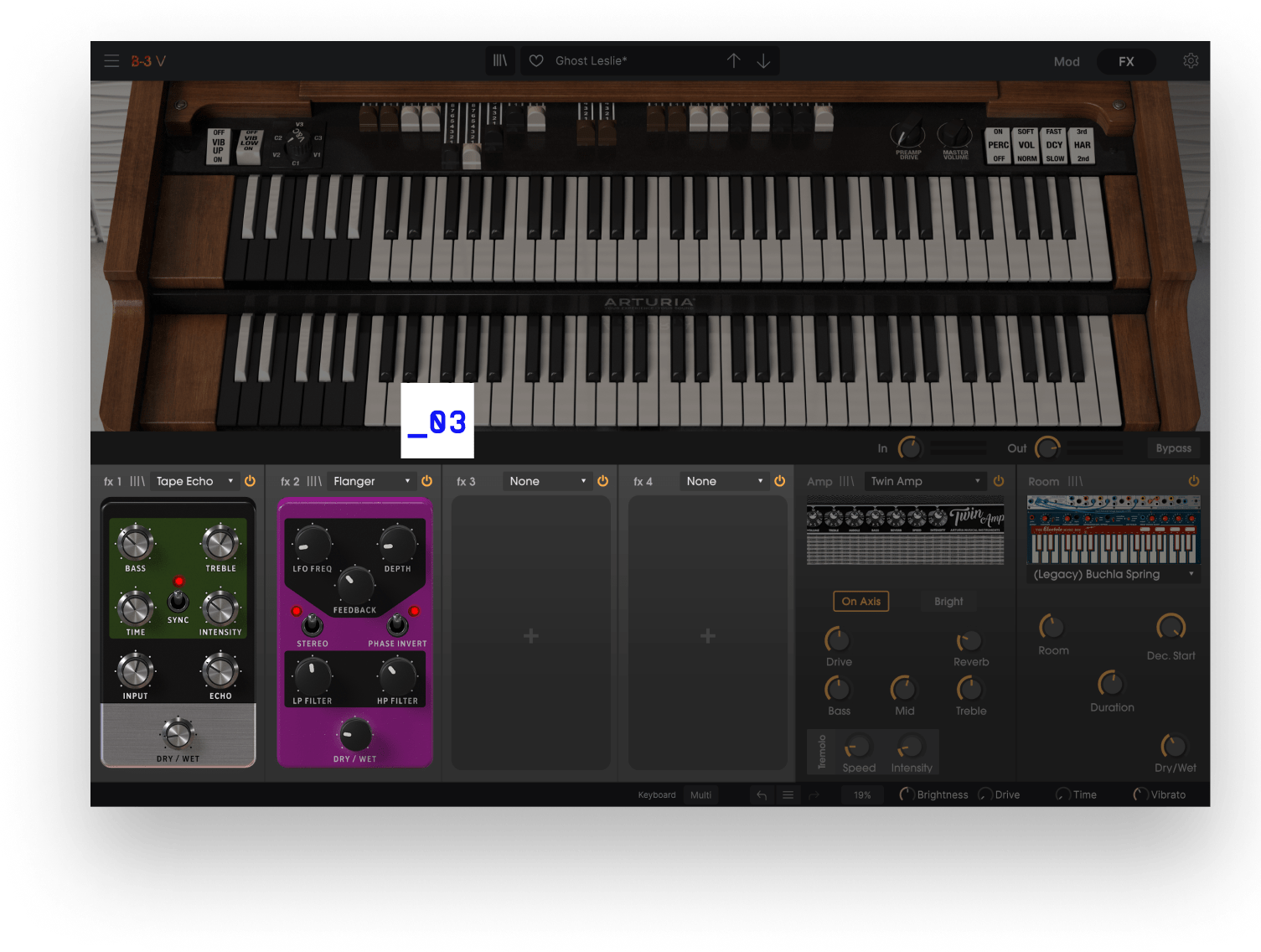
13 effects profiles to choose from to enhance and personalize the tone of B-3, from spatial effects, to distortion, dynamics and sound-widening modulations.
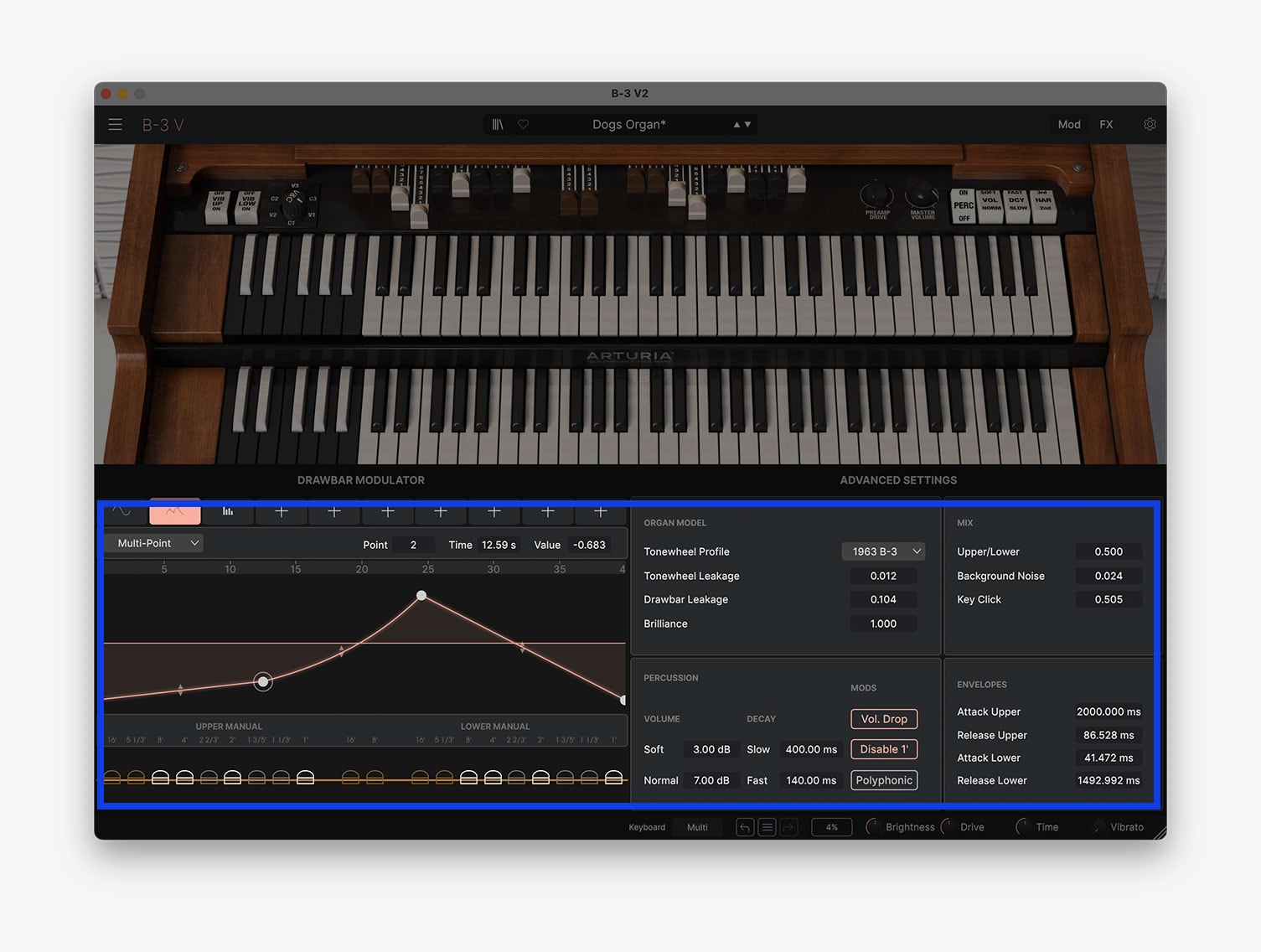
Regresa al pasado con varias ediciones y modelos, y controla con exactitud cuánta interferencia se produce (se da cuando las ruedas armónicas y barras de armónicos son captadas por otras adyacentes).
Escúchalo
en acción
Parta de lo que hizo al B3 tan atractivo era su flexibilidad: con los ajustes adecuados para las barras de armónicos, podía servir literalmente para cualquier estilo de música.
Estas demos de sonido prueban que nuestro B-3 V es aún más flexible.
Last Minute_Jam
Organ from the B-3V using one of the classic presets. Bassline comes from Mini V3. Electric piano sounds courtesy of the Stage-73 V.
Black Bug
Classic 60s Organs
Classic 70s Organs
Snake Eyes
Low B
Presets
Explora creaciones de los mejores artesanos sonoros del mundo en el explorador de presets del B-3 V, facilísimo de usar.
Tenemos el privilegio de trabajar con algunos de los mejores diseñadores de sonido del mundo. Busca, etiqueta y filtra sus creaciones por tipo y estilo, y descubre en cuántos órganos distintos se puede convertir el B-3 V. EA continuación, crea tus propios presets y añade descripciones detalladas.

Artistscorner

Incluido en
V collection
Teclados míticos reinventados
Este instrumento también forma parte de la V Collection, el repertorio completo más fantástico de instrumentos míticos: sintetizadores, órganos, pianos y demás que revolucionaron la historia de los teclados. Están modelados con las tecnologías más avanzadas para lograr el máximo realismo y los hemos mejorado con nuevas opciones creativas. Tanto si la utilizas como plugins de en el DAW en tu estudio como si la usas de forma autónoma en los conciertos, la V Collection pone los mejores teclados de la historia al alcance de tu mano para que te inspires al instante.
Más información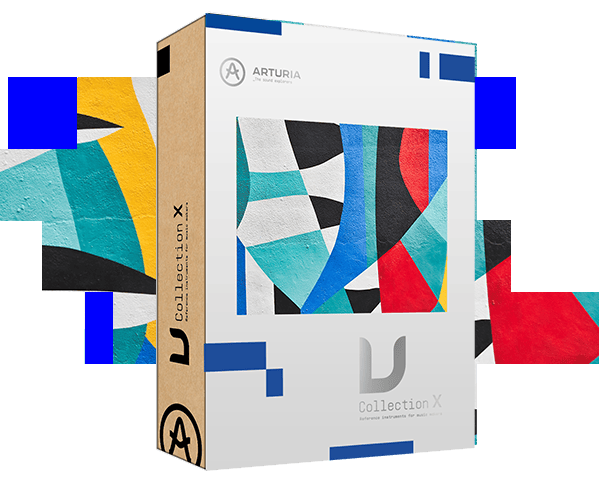
Las características
necesitas

Los tutoriales integrados en la app te guían en todos los aspectos del instrumento, desde parámetros individuales hasta consejos de nuestros diseñadores de sonido, para que te puedas centrar en la parte creativa. Cuesta creer que resulte tan fácil, pero así es.

Arturia Software Center te permite descargar, organizar y actualizar todo tu software de Arturia desde el mismo sitio, además de gestionar tus licencias en varios dispositivos. Así de sencillo.

Nuestros instrumentos virtuales y plugins están diseñados para integrarse fácilmente en tu estudio. Sea cual sea tu estilo, podrás explorar los sonidos y disfrutar de total compatibilidad con los principales DAW, tanto en Windows como en MacOS.

Encuentra al instante el sonido que tienes en mente gracias a la exploración inteligente y optimizada de presets. Busca con palabras clave, explora por tipo de instrumento, estilo musical, etc… Hasta puedes guardar tus presets favoritos para acceder rápidamente a ellos más adelante.

Tanto si buscas las inmersión visual completa de nuestras emulaciones de instrumentos clásicos como si prefieres ocupar el menor espacio en pantalla, las interfaces de todos tus instrumentos virtuales Arturia se pueden redimensionar a la escala que mejor te vaya.

Los instrumentos vienen preasignados de forma natural para la gama de controladores Arturia KeyLab, aunque también funcionarán estupendamente con otros controladores MIDI. Macros para alterar los sonidos al instante, integración sencilla con tu DAW y funcionamiento autónomo.
Basado en TAE®
La tecnología exclusiva de modelado analógico que hace que nuestras emulaciones sean indistinguibles de los originales.
Limitando con precisión las características de los osciladores analógicos, los filtros y el recorte suave, podemos conseguir un asombroso detalle a nivel de componentes y el auténtico sabor analógico a partes iguales.
Más información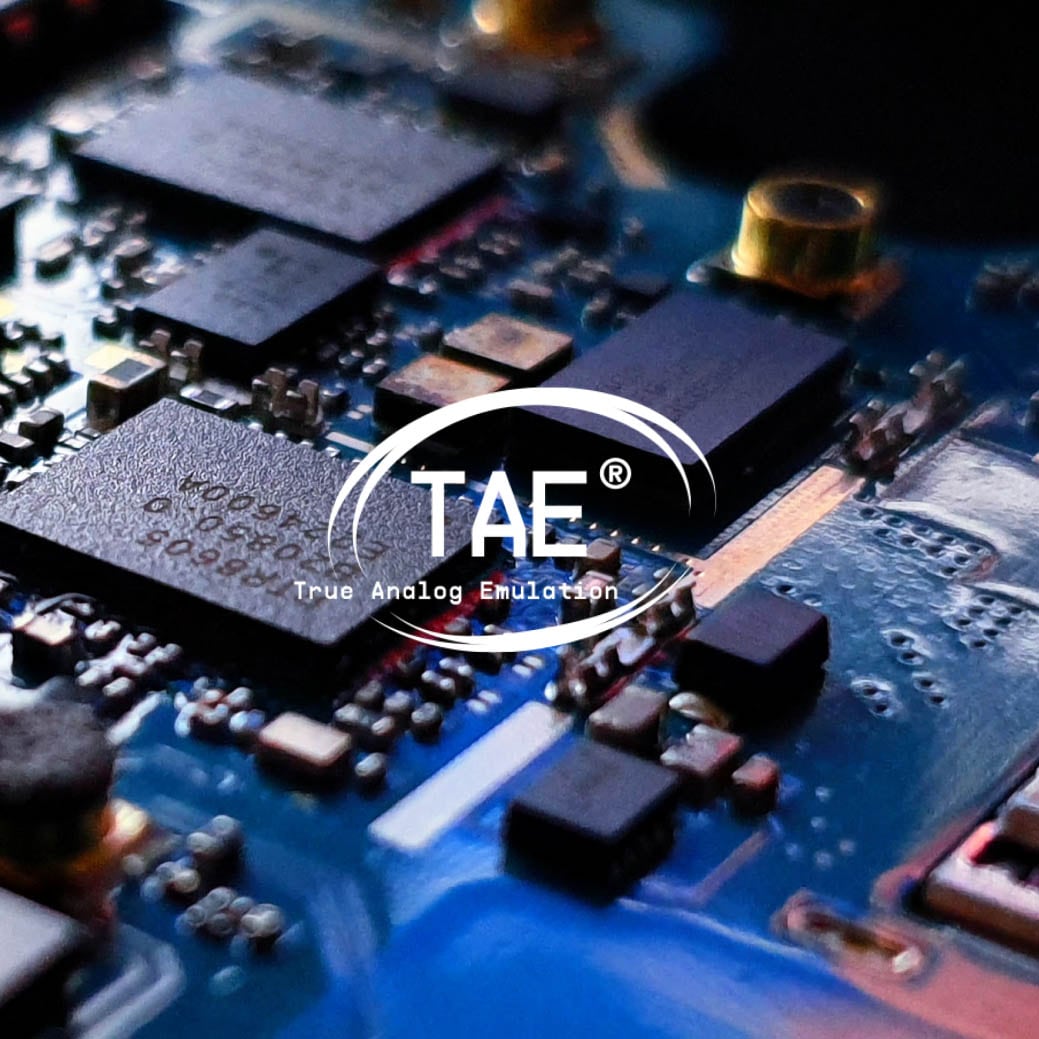
Galería
Características principales
Motor de modelado físico (sin samples)
Interfaz de dos manuales
Cada manual tiene preferencias independientes de canal MIDI
9 barras de armónicos por manual
3 chorus modelados y ajustes de vibrato
Controles ON/OFF superior e inferior independientes
Drive de previo
Emulador de altavoz giratorio
Controles avanzados para ajustar el modelo
Reverb de convolución
Controles tradicionales de interpretación con Leslie
Pedal de intensidad
Controles de percusión
- Activado/desactivado
- Volumen suave/normal
- Decay lento/rápido
- Selección de armónicos
Efectos de salida que puedes reordenar
- Volumen, wah, auto-wah
- Flanger
- Compresor
- Chorus
- Delay analógico
Nuevos moduladores avanzados para las barras de armónicos
- LFO con varias formas de onda y fase
- Envolventes de varios puntos
- Secuenciador por pasos
- Destinos de las barras de armónicos con controles de cantidad positiva y negativa
Mod view
- Interferencia de las barras de armónicos
- Interferencia de la rueda armónica
- Brillo
- Ruido de fondo
- Percusión polifónica
- Volumen de clic de tecla
- Controles de ataque y release
50 presets de fábrica
Asignación MIDI fácil de usar
Requisitos de plataforma
Windows
- Win 10+ (64bit)
- 4 GB RAM
- Procesador de 4 núcleos a 3,4 GHz (4,0 GHz en modo Turbo)
- 3 GB de espacio libre en disco
- Gráfica compatible con OpenGL 2.0
- No funciona con procesadores ARM en Windows
Configuración mínima
- Funciona de forma autónoma y como VST, AAX, Audio Unit y NKS (únicamente en DAW de 64-bits).





Apple
- Mac OS 11+
- 4 GB RAM
- Procesador de 4 núcleos, 3,4 GHz (4,0 GHz en modo Turbo) o procesador M1
- 3 GB de espacio libre en disco
- Gráfica compatible con OpenGL 2.0
Funciona con ASC
- Una solución elegante y sencilla para instalar, activar y actualizar tus instrumentos virtuales de Arturia.
Todos los nombres de fabricantes y productos mencionados en esta página son marcas comerciales de sus respectivos titulares, que de ninguna manera están asociados o afiliados con Arturia. Las marcas comerciales de otros fabricantes se usan únicamente para identificar los productos de aquellos fabricantes cuyas características y sonido se estudiaron durante el desarrollo. Todos los nombres de equipos, inventores y fabricantes se han incluido únicamente con fines ilustrativos y educativos, y no sugieren ninguna afiliación ni respaldo por parte de ningún inventor o fabricante de equipos.

